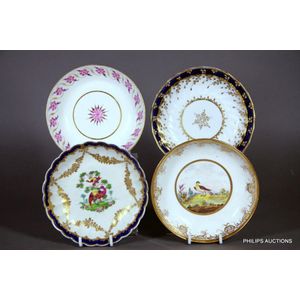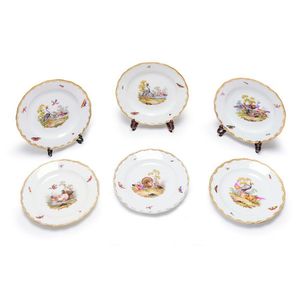Haviland Limoges Gilt Supper Set with Swag Decoration
You must be a subscriber, and be logged in to view price and dealer details.
Subscribe Now to view actual auction price for this item
When you subscribe, you have the option of setting the currency in which to display prices to $Au, $US, $NZ or Stg.
- Floral Swag / Garland / Festoon - Floral swags are a decorative motif often used in the ornamentation of various objects, such as silverware, glassware, and furniture. The term "swag" refers to a garland or wreath of flowers, foliage, or other decorative elements, which is usually arranged in a loop or curve.
Floral swags can be found in a variety of decorative styles, from ornate Baroque and Rococo designs to more naturalistic Art Nouveau and Art Deco styles. They are often used to add a touch of elegance, refinement, or whimsy to an object, and can be seen on a range of items from chandeliers and candlesticks to picture frames and tea sets.
In the decoration of silver objects, floral swags are often used to accentuate the curves and lines of the piece, and to add visual interest to the surface. Similarly, on glass objects, floral swags may be used to frame or highlight a particular area of the object, or to add a touch of color and delicacy.
On furniture, floral swags can be found on a variety of pieces, from cabinets and armoires to chairs and sofas. They are often used to enhance the lines and curves of the furniture, and can be used to create a sense of movement and flow in the design.
Overall, floral swags are a versatile decorative element that can be adapted to a range of styles and applications, and have been used in the decoration of various objects throughout history. - Edwardian - The Edwardian period of English furniture and decorative arts design is named for Edward VII (1841 ? 1910) who was King of the United Kingdom and the British Dominions and Emperor of India for the brief period from 1901 until his death in 1910. It follows the Victorian period, in turn was followed by the Art Nouveau and Art Deco styles. In Australia, designs of this period are also known as being in the Federation style.
- Comport - A comport is a type of decorative serving dish or bowl, typically used for desserts, fruits or other sweet treats. The comport is usually made from glass, silver or porcelain, which are materials known for their elegance and durability. They are often beautifully designed and decorated, and can be used as an elegant and decorative centerpiece for a table or dining room. They are also widely used as a decorative piece on the mantelpiece, sideboard, or other areas of the house.
This item has been included into following indexes:
- Haviland & Cie. (Limoges, France) - ceramics 30
- Limoges (France)
Visually similar items

Four saucers by Chamberlain Worcester, Pinxton, circa 1780s-1810, two items unmarked, a Chamberlain Worcester shanked saucer pattern N.66; a Worcester fluted bowl with a fancy bird, crescent mark underside and an unmarked Worcester saucer; a Pinxton saucer

A set of six Meissen porcelain plates, circa 1880, each plate hand painted with exotic birds to centre, and butterfly designs to rim, blue under glazed double sword mark to underside, 23.5 cm diameter

Early 13 piece dessert set. Derby? including 11 plates & two various comports. All with painted blossom pattern, gilt rims. Depth 23 cm (plates)

Early 13 piece dessert set. Derby? including 11 plates (1 cracked) & two various comports. All with painted blossom pattern, gilt rims. Estate late Margaret Goldfinch. Diameter 23 cm. (plates)
